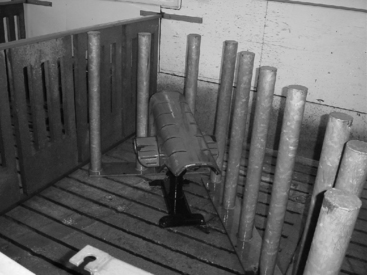CHAPTER 97 Artificial Insemination in Swine: Boar Stud Management
BOAR HOUSING
Semen collection should be performed in a pen specifically designed for this task. Because personnel are operating close to the boar, the pen should be designed to allow multiple escape sites out of the pen if the boar becomes aggressive. Two or three of the perimeter walls should be constructed using a 5-cm-outer-diameter (OD) galvanized pipe. This pipe should be approximately 1 m in height and placed at 0.3-m intervals on center. The height and the space (approximately 0.25 m) between pipes should allow personnel to easily enter and exit the collection area without having to open or close gates but restrict the boar to the pen area. Collection pens should be 1.8 to 2.4 m in width and 2.4 to 2.75 m in length. A stable collection dummy (Fig. 97-1) should be placed in the collection pen. Added features of collection dummies may include capability for height adjustment and some type of support on the sides of the dummy that allow the boar to stabilize his front legs during mounting and thrusting. It is paramount that a nonslip surface be provided around the dummy so that the boar has secure footing during mounting and thrusting. It may be helpful to position the collection dummy in a corner of the pen or with one end against the wall so that the boar can easily be directed and maintained around the dummy. The pen and the collection dummy should be situated away from boars and other distractions that would divert the boar’s attention away from the collection dummy. Some stud operators design their facilities to include a pen—commonly called a “warm-up” pen—that is in close proximity to the semen collection pen. This pen is used to queue a boar so that he observes and hears the actions of another boar in the collection pen; these stimuli frequently help to excite the boar, so that when he is moved into the semen collection pen, reaction time to mount of the dummy sow is minimal, and semen collection can be accomplished more efficiently.
BOAR NUTRITION
Much early work addressed the effects of restricted nutrient intake on boar reproductive performance. Restrictions or deficiencies in protein,1,2 energy,2 and certain vitamins and minerals3,4 have been shown to negatively affect boar reproductive performance. Conversely, overfeeding and excess body conditioning also can have a negative impact on boar reproduction. Ideally, adequate nutrition should be provided to active boars to meet their requirements for maintenance, growth, breeding activity, and sperm production. In general, feed intake is adequate in young (<16 months) boars if they show moderate (400 g/day) weight gains, and in mature boars if they show slight (200 g/day) weight gains. In practice, body condition scoring most often is used as an indicator of health and adequate feed intake. Depending on genetics and structural conformation, a body condition score of 3 to 3.5 (on a scale of 1 to 5) is a desirable target. To obtain a more objective assessment, backfat monitoring by means of B-mode ultrasonography also is being used to monitor boar body condition.
Feed constituents for boar diets vary widely and usually are dictated by local availability. Cost has become less important than with other swine diets because the boar ration is fed to only a small but valuable number of animals in a herd. A typical ration used in an AI boar stud operation contains approximately 3000 metabolizable energy (ME) kcal/kg, 16% to 18% crude protein (0.85% lysine), 4% fat, and 5% fiber.5 Generally, a boar will consume 1.5 to 3.0 kg of this ration on a daily basis. Daily allowances may be modified according to season and environmental conditions. Thermoneutrality for the boar is approximately 20° C.6 If temperatures fall below 20° C, the amount of feed provided to boars should be increased by 0.08 kg/day for every 1° C decrease. During periods of warmer ambient temperatures, it is not advisable to decrease feed amount, because this may lead to an unbalanced diet. Instead, energy density of the diet may be reduced to decrease body heat production but still maintain the ration’s balance. Nutritional supplements such as certain vitamins, minerals, and fatty acids have been advocated as aids for improving or maintaining boar semen quality and quantity under stressful environmental or nutritional conditions; further research is warranted.
SEMEN COLLECTION
Contamination should be minimized when semen is being collected for use in an AI breeding program7 (Box 97-1). Application of digital pressure to the penis using the gloved hand technique is the most popular method for collecting boar semen. Nonspermicidal gloves (e.g., vinyl, nitrile) should be used by the semen collector; some glove materials (e.g., latex) have been found to be spermicidal in this species.8 The semen collector should place two gloves on the collecting hand. After the boar has mounted the collection dummy and has commenced thrusting, the collector reaches underneath the boar and massages the sheath. Sheath massage will allow for evacuation of contaminant preputial fluids and aid in exteriorizing the penis. After the penis is exteriorized, the top glove is discarded. Holding the semen collection container (e.g., a prewarmed, insulated thermos or Styrofoam cup with a filter over the opening) in the free, ungloved hand, the collector then kneels down and grasps the boar’s corkscrew-shaped glans penis with the gloved hand. Constant pressure is applied to the glans penis with the fingers, so that the glans penis is “locked” in the hand; this grasp mimics the cervical lock that occurs during natural mating. Pressure applied elsewhere on the penis may elicit a negative response. If adequate pressure is applied, the boar will respond positively by fully extending his penis.
Data from Althouse GC, Kuster CE, Clark SG, et al: Field investigations of bacterial contaminants and their effects on extended porcine semen. Theriogenology 2000;53:1167–1176.




